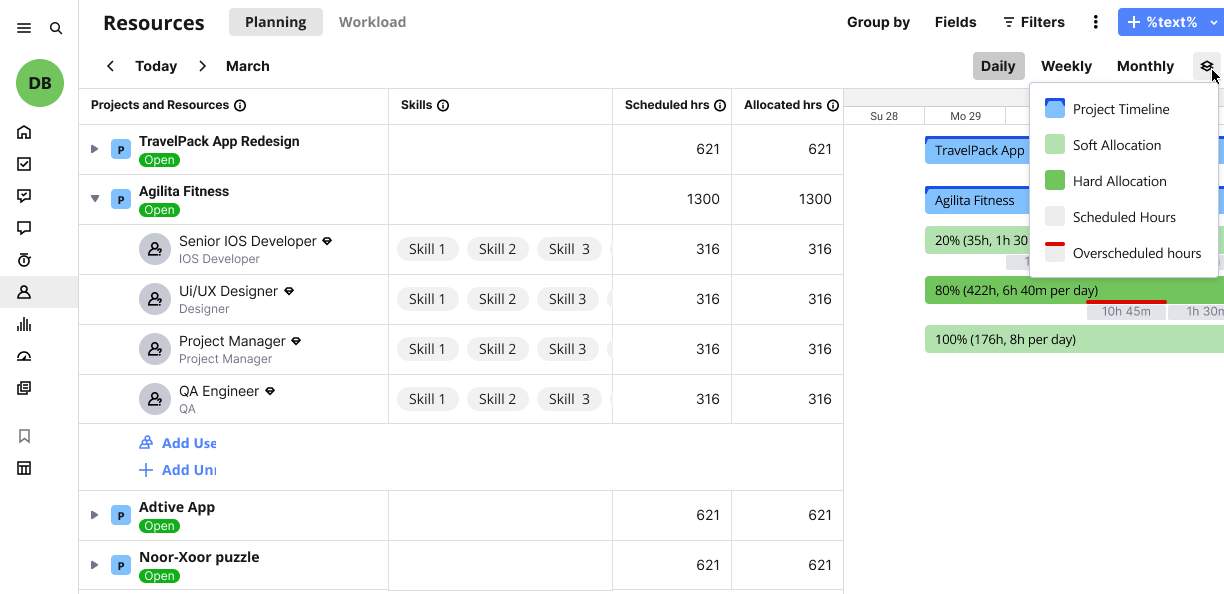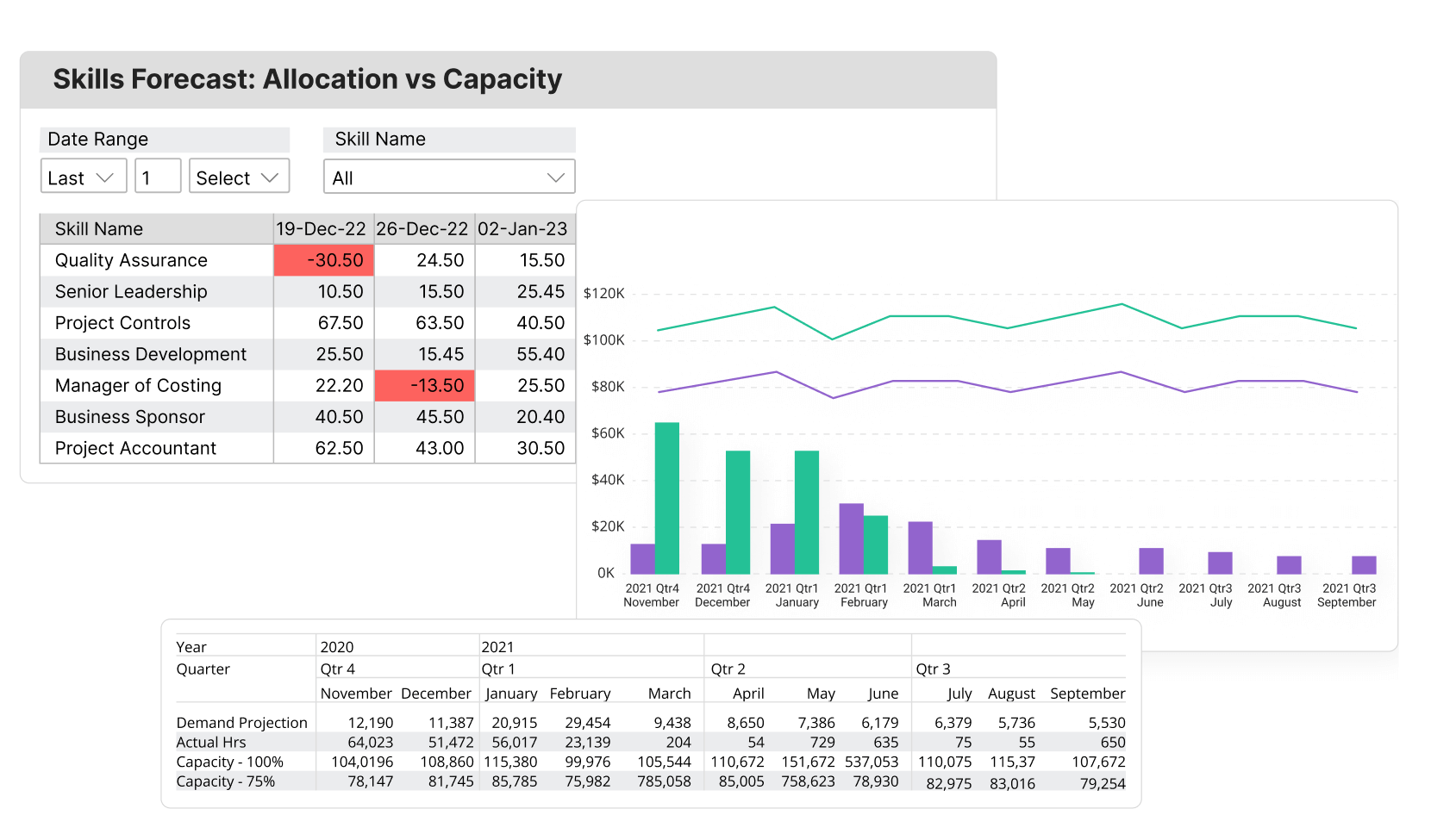In today’s fast-paced business world, effective resource planning is essential for professional services organizations. Managing your resources well can be the key to a project‘s success.
In this guide, we‘ll dive into how blending strategic resource planning with traditional workload management can improve efficiency, adaptability, and overall project success. Plus, we‘ll explore how sometimes a bottom-to-top approach–starting with a detailed project plan and then auto-generating resource allocations–can be a game changer. We‘ll outline when each approach works best and give you practical steps for implementation.
What is traditional workload management?
Traditional workload management focuses on the nuts and bolts of project execution, like creating detailed plans with specific tasks, timelines, and resource assignments. It‘s a micro-level approach, zeroing in on what needs to be done, when, and by whom. This method is especially effective for organizations that need clear, step-by-step project control.
Once the plan is created, it serves as the roadmap for project delivery. Teams can follow the structure laid out, ensuring tasks are completed on time and resources are used efficiently. The strength of traditional workload management lies in its structured approach, providing project managers with a solid grip on project progress.
The strengths of traditional workload management
- Clarity & Accountability: One of the key benefits of traditional workload management is the clarity it brings. Every team member knows exactly what tasks they are responsible for and when they are due. There is no ambiguity, which fosters accountability across the board.
- Progress tracking: By setting specific tasks and deadlines, managers can track progress down to the individual task level. This allows them to spot delays or issues early and adjust before they snowball into bigger problems.
- Risk management: Since each task is clearly outlined, it‘s easier to identify risks early in the process. Potential issues can be flagged as tasks are delayed or resources are stretched, allowing for quicker mitigation.
- Resource optimization: Assigning tasks to specific individuals allows for precise workload balancing. Managers can see who is over- or under-assigned and make adjustments accordingly to ensure that no one is overloaded.
The drawbacks of traditional workload management
Despite its strengths, this approach isn‘t without its challenges:
- Time-Consuming: Developing detailed plans can take significant time, often delaying the start of a project. It requires upfront effort to break down projects into smaller tasks and assign resources accordingly.
- Inflexibility: When things change–as they inevitably do–adjusting a detailed plan can be cumbersome. If the scope shifts or new priorities emerge, it might require reworking the entire plan, causing delays.
- Delayed visibility on resource constraints: Traditional workload management is often reactive in nature. Resource shortages may not be apparent until the plan is fully built out, making it harder to adjust capacity at the start.
- Reactive management: Issues are often addressed only after they impact the project, as this method tends to focus more on task completion than proactive planning for potential resource challenges.
When traditional management works best
Traditional workload management shines in certain situations:
- Well-Defined projects: Projects with clear, stable objectives and minimal expected changes are perfect for this approach. If you know exactly what needs to be done and the scope is unlikely to shift, traditional planning offers the control needed to ensure everything goes smoothly.
- Stable environments: In industries where the business landscape doesn’t change frequently, like construction or manufacturing, this approach works well. The lack of sudden shifts means detailed plans can be followed without constant adjustments.
- Regulatory compliance: For projects requiring strict adherence to regulations, such as pharmaceutical trials or safety-compliant construction, detailed planning is critical. It ensures all necessary steps are completed, documented, and followed rigorously.
Example: A construction project that needs precise coordination among various teams and adherence to safety regulations is a prime candidate for traditional workload management. Everything from deadlines to responsibilities must be carefully planned out to ensure safety and compliance.
What is strategic resource planning?
Strategic resource planning takes a high-level, big-picture view. Instead of diving immediately into task assignments, it focuses on aligning resources with business goals before detailed planning starts. By assessing roles and skills needed, it gives organizations flexibility and room to adapt as projects evolve.
In this approach, managers allocate resources based on projected demand and availability, rather than locking down specific individuals into detailed tasks right away. The result is a more fluid resource management process that is highly adaptable to changing conditions, whether that means project shifts, scope changes, or unexpected resource challenges.
The benefits of strategic resource planning
- Early capacity analysis: One of the key advantages of strategic resource planning is the ability to assess resource availability before jumping into task details. By looking at the big picture first, you can identify whether you have enough capacity to take on new projects or whether additional resources need to be hired or shifted to meet demand.
- Proactive management: Rather than waiting for resource issues to emerge during the planning process, this approach allows managers to identify potential gaps or surpluses early. This ensures that there is time to make adjustments before they impact project execution.
- Flexibility: Strategic planning is inherently flexible. Because it focuses on allocating roles and skills rather than specific tasks, it allows managers to quickly reallocate resources if priorities shift or new projects emerge.
- Alignment with business goals: By focusing on high-level resource planning, organizations can ensure that their resource allocation is aligned with broader business objectives. This helps prevent resources from being tied up in low-priority tasks that don‘t contribute to the organization‘s strategic goals.
The drawbacks of strategic resource planning
While it offers flexibility, strategic planning has some limitations:
- Lack of task-level detail: By focusing on the macro level, strategic planning might miss some of the nuances that come with detailed project execution. Task-specific needs or small inefficiencies can be overlooked, causing minor disruptions later.
- Risk of misalignment: Without a strong handoff from strategic to task-level planning, there‘s a risk that high-level plans won‘t fully translate to the detailed execution phase. This can lead to gaps in resource allocation and project delivery.
When strategic planning makes sense
Strategic resource planning is ideal for scenarios like:
- Uncertain projects: When you‘re dealing with projects in a fast-changing environment, where the scope is likely to evolve, strategic planning provides the flexibility you need to make quick adjustments.
- Long-term planning: For organizations looking to forecast their resource needs over time, this approach allows for better long-term capacity planning. It‘s useful for businesses that want to make sure they have the right skills and roles available for future initiatives.
- Managing pipelines: Strategic planning is invaluable when managing multiple projects in the pipeline. By looking at potential upcoming projects, organizations can assess how they will impact existing resources and ensure that no team members are overextended.
- Multiple projects: If you‘re managing resources across multiple projects, strategic planning allows you to allocate roles based on skill sets rather than overloading specific individuals. This macro view makes it easier to balance workloads across the entire portfolio.
Example: An IT consulting firm planning for resource allocation across a range of potential projects. Without knowing all the details yet, they can allocate resources based on projected needs, giving them the flexibility to shift as projects evolve.
Bottom-up approach: creating detailed plans first, then auto-generating allocations
While strategic planning offers a top-down view, another method involves starting with a bottom-up approach. In this case, teams create detailed project plans first, and then use those plans to auto-generate resource allocations. By leveraging software tools, the detailed task schedule is used to automatically assign roles and resources based on availability.
How bottom-up planning works
- Start with detailed task planning: Instead of assigning roles at a high level, this approach begins by breaking down the project into detailed tasks with deadlines, dependencies, and time estimates.
- Auto-generate resource allocations: Once the plan is created, resource management software can auto-generate resource assignments based on availability, required skills, and capacity. The system matches team members to tasks based on the predefined project schedule, streamlining the process.
- Optimizing resources: This approach ensures that no time is wasted in manual resource allocation, and the software can optimize for workload balancing, efficiency, and productivity.
When bottom-up planning makes sense
- Well-defined projects: When the project scope is clearly defined, detailed task planning offers the precision needed for smooth execution.
- Tight deadlines: For projects where time is of the essence, generating allocations based on the existing schedule can speed up the planning phase.
- Small teams: In smaller teams where roles are flexible, this method allows for efficient use of limited resources without needing a top-down strategic plan.
Why a hybrid approach is best
Blending strategic resource planning with traditional workload management gives you the best of both worlds–macro-level alignment paired with detailed execution. Adding in the bottom-up approach allows you to generate resource allocations directly from project plans, which can streamline the resource assignment process even further.
Key advantages of a hybrid approach
- Balanced view: Strategic resource planning provides a big-picture view, while traditional workload management ensures detailed oversight of tasks. This combination means you‘re never caught off-guard by resource shortages or delays.
- Increased adaptability: High-level plans can be adjusted as needed without having to completely rework detailed tasks. Meanwhile, starting with detailed project plans and generating automatic allocations ensures that your resources are always optimized.
- Better resource utilization: The hybrid approach optimizes resource use by blending the strategic flexibility of high-level planning with the precision of task assignments. Resources are allocated both based on broader business goals and the specific needs of each project.
- Alignment with business goals: This method ensures that while the day-to-day execution is being managed effectively, the overall resource allocation is still aligned with the organization’s objectives.
Strategic planning and pipeline management
Strategic resource planning is especially valuable for assessing the impact of potential projects before they‘re finalized. It gives organizations the power to manage the pipeline efficiently by anticipating resource needs for projects still in the early stages of development.
Managing the pipeline
- Early integration: Import potential projects from CRM into your PSA system early on to gauge resource demands. This gives you insight into how new deals will affect current workloads.
- Impact assessment: Understanding the resource impact of potential projects allows you to adjust early. If a big contract is on the horizon, you can ensure the team is ready by ramping up hiring, shifting priorities, or scheduling additional training.
- Proactive planning: This process ensures that you‘re not caught flat-footed by new contracts or changing demands. Proactive planning for the pipeline allows you to remain flexible and responsive to new business opportunities.
Example: At FutureTech Consulting, integrating CRM data into PSA software provided visibility into future projects. This foresight helped them decide whether to hire additional staff or reprioritize existing resources, avoiding over commitment and improving client satisfaction.
Tools to help you implement strategic resource planning
Birdview PSA offers comprehensive solutions to help you manage both top-down strategic planning and bottom-up workload management effectively. With tools that bridge both approaches, Birdview PSA.
With Birdview PSA, you can see the availability and utilization of each team member at a glance. The Resource Center provides a centralized view, showing who is booked, who has capacity, and where adjustments may be needed. Instead of waiting for bottlenecks to occur, you can proactively manage resource allocation to ensure no one is overloaded or underutilized.
One of the standout features of Birdview PSA is its ability to intelligently allocate resources based on skill sets, project needs, and availability. When assigning tasks, there‘s no guesswork involved in who‘s best for the job – the platform helps match tasks with the most suitable team members.

Birdview PSA is a modern project management software that helps you forecast future resource needs. By analyzing historical data and current changes, you can anticipate when you will need to bring in additional resources or reassign tasks to keep your project on schedule.

Strategic resource planning is not just about managing your current workload. It‘s about planning ahead. Birdview PSA lets you plan for both short-term tasks and long-term project milestones at the same time.
Conclusion
Combining strategic resource planning with traditional workload management–and integrating a bottom-up approach–gives organizations the flexibility, control, and foresight needed to excel in today‘s dynamic business environment. By leveraging these approaches, along with powerful tools like Birdview PSA, your organization can improve adaptability, boost efficiency, and keep resource management aligned with long-term business goals.
Next Steps:
- Assess your current planning processes. Are you missing opportunities for strategic alignment or efficiency?
- Engage with stakeholders to ensure buy-in on the benefits of combining these approaches.
- Explore tools like Birdview PSA to enhance your planning capabilities and better manage your project pipeline.
By embracing a comprehensive approach to resource planning, you‘ll be better equipped to navigate the complexities of project management and resource allocation, ensuring greater project success and organizational growth.
Related resource management articles
If you want to explore resource management further, Birdview PSA is here to help. Along with our project and resource management software, you‘ll get access to free templates, blogs, Guides, and eBooks. Here‘s a sample of that content as related to our topic.
Resource Management in Project Management: Process, Tools, Benefits & Technique
5 Common Resource Allocation Problems and How to Solve Them
Capacity Planning and Resource Planning: What is Different?
Resource leveling (definitions, examples & how to use efficiently)



